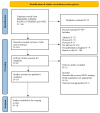Efficacy of educational interventions on improving medical emergency readiness of rural healthcare providers: a scoping review
- PMID: 39061016
- PMCID: PMC11282721
- DOI: 10.1186/s12913-024-11116-7
Efficacy of educational interventions on improving medical emergency readiness of rural healthcare providers: a scoping review
Abstract
Background: Medical emergencies are the leading cause of high mortality and morbidity rates in rural areas of higher and lower-income countries than in urban areas. Medical emergency readiness is healthcare providers' knowledge, skills, and confidence to meet patients' emergency needs. Rural healthcare professionals' medical emergency readiness is imperative to prevent or reduce casualties due to medical emergencies. Evidence shows that rural healthcare providers' emergency readiness needs enhancement. Education and training are the effective ways to improve them. However, there has yet to be a scoping review to understand the efficacy of educational intervention regarding rural healthcare providers' medical emergency readiness.
Objectives: This scoping review aimed to identify and understand the effectiveness of educational interventions in improving rural healthcare providers' medical emergency readiness globally.
Methods: The Preferred Reporting Items for Systematic Reviews and Meta-Analyses extension for scoping reviews were used to select the papers for this scoping review. This scoping review was conducted using MEDLINE, CINHAL, SCOPUS, PUBMED and OVID databases. The Population, Intervention, Comparison and Outcome [PICO] strategies were used to select the papers from the database. The selected papers were limited to English, peer-reviewed journals and published from 2013 to 2023. A total of 536 studies were retrieved, and ten studies that met the selection criteria were included in the review. Three reviewers appraised the selected papers individually using the Joanna Briggs Institute [JBI] critical appraisal tool. A descriptive method was used to analyse the data.
Results: From the identified 536 papers, the ten papers which met the PICO strategies were selected for the scoping review. Results show that rural healthcare providers' emergency readiness remains the same globally. All interventions were effective in enhancing rural health care providers' medical emergency readiness, though the interventions were implemented at various durations of time and in different foci of medical emergencies. Results showed that the low-fidelity simulated manikins were the most cost-effective intervention to train rural healthcare professionals globally.
Conclusion: The review concluded that rural healthcare providers' medical emergency readiness improved after the interventions. However, the limitations associated with the studies caution readers to read the results sensibly. Moreover, future research should focus on understanding the interventions' behavioural outcomes, especially among rural healthcare providers in low to middle-income countries.
Keywords: Educational interventions; Medical emergencies; Rural healthcare providers; Scoping review.
© 2024. The Author(s).
Conflict of interest statement
The authors declare no competing interests.
Similar articles
-
Beyond the black stump: rapid reviews of health research issues affecting regional, rural and remote Australia.Med J Aust. 2020 Dec;213 Suppl 11:S3-S32.e1. doi: 10.5694/mja2.50881. Med J Aust. 2020. PMID: 33314144
-
Promoting and supporting self-management for adults living in the community with physical chronic illness: A systematic review of the effectiveness and meaningfulness of the patient-practitioner encounter.JBI Libr Syst Rev. 2009;7(13):492-582. doi: 10.11124/01938924-200907130-00001. JBI Libr Syst Rev. 2009. PMID: 27819974
-
The impact of knowledge on attitudes of emergency department staff towards patients with substance related presentations: a quantitative systematic review protocol.JBI Database System Rev Implement Rep. 2015 Oct;13(10):133-45. doi: 10.11124/jbisrir-2015-2203. JBI Database System Rev Implement Rep. 2015. PMID: 26571289
-
Anti-stigma initiatives for mental health professionals-A systematic literature review.J Psychiatr Ment Health Nurs. 2022 Aug;29(4):512-528. doi: 10.1111/jpm.12840. Epub 2022 May 16. J Psychiatr Ment Health Nurs. 2022. PMID: 35500153
-
The effects of interactive training of healthcare providers on the management of life-threatening emergencies in hospital.Cochrane Database Syst Rev. 2019 Sep 24;9(9):CD012177. doi: 10.1002/14651858.CD012177.pub2. Cochrane Database Syst Rev. 2019. PMID: 31549741 Free PMC article.
Cited by
-
Research on the construction strategy of China's rural emergency linkage system from the perspective of systems theory-based on the survey of six regions in China.Front Public Health. 2025 Jul 4;13:1611273. doi: 10.3389/fpubh.2025.1611273. eCollection 2025. Front Public Health. 2025. PMID: 40687140 Free PMC article.
-
The five-link theory for improving the integrated and balanced development of emergency medical care in urban and rural areas.J Glob Health. 2025 Jul 1;15:03023. doi: 10.7189/jogh.15.03023. J Glob Health. 2025. PMID: 40587197 Free PMC article.
References
-
- World Health Organization. The top 10 causes of death. 2020. Retrieved from https://www.who.int/news-room/fact-sheets/detail/the-top-10-causes-of-death.
-
- Scheil-Adlung X. Global evidence on inequities in rural health protection: new data on rural deficits in health coverage for 174 countries. International Labour Organization; 2015.
-
- The World Bank. Rural population (% of total population). 2021. Retrieved from https://data.worldbank.org/indicator/SP.RUR.TOTL.ZS.
Publication types
MeSH terms
LinkOut - more resources
Full Text Sources
Medical
Miscellaneous


